AMD's Radeon HD 5870: Bringing About the Next Generation Of GPUs
by Ryan Smith on September 23, 2009 9:00 AM EST- Posted in
- GPUs
Cypress: What’s New
With our refresher out of the way, let’s discuss what’s new in Cypress.
Starting at the SPU level, AMD has added a number of new hardware instructions to the SPUs and sped up the execution of other instruction, both in order to improve performance and to meet the requirements of various APIs. Among these changes are that some dot products have been reduced to single-cycle computation when they were previously multi-cycle affairs. DirectX 11 required operations such as bit count, insert, and extract have also been added. Furthermore denormal numbers have received some much-needed attention, and can now be handled at full speed.
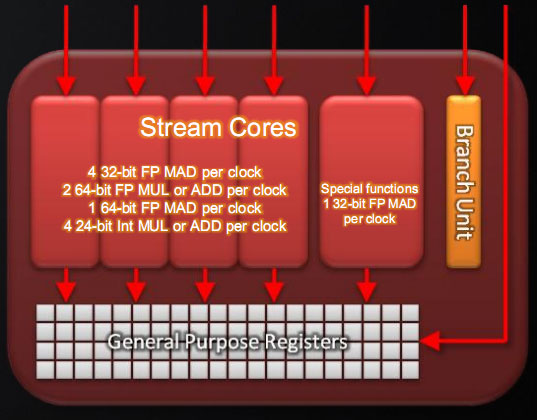
Perhaps the most interesting instruction added however is an instruction for Sum of Absolute Differences (SAD). SAD is an instruction of great importance in video encoding and computer vision due to its use in motion estimation, and on the RV770 the lack of a native instruction requires emulating it in no less than 12 instructions. By adding a native SAD instruction, the time to compute a SAD has been reduced to a single clock cycle, and AMD believes that it will result in a significant (>2x) speedup in video encoding.
The clincher however is that SAD not an instruction that’s part of either DirectX 11 or OpenCL, meaning DirectX programs can’t call for it, and from the perspective of OpenCL it’s an extension. However these APIs leave the hardware open to do what it wants to, so AMD’s compiler can still use the instruction, it just has to know where to use it. By identifying the aforementioned long version of a SAD in code it’s fed, the compiler can replace that code with the native SAD, offering the native SAD speedup to any program in spite of the fact that it can’t directly call the SAD. Cool, isn’t it?
Last, here is a breakdown of what a single Cypress SP can do in a single clock cycle:
- 4 32-bit FP MAD per clock
- 2 64-bit FP MUL or ADD per clock
- 1 64-bit FP MAD per clock
- 4 24-bit Int MUL or ADD per clock
- SFU : 1 32-bit FP MAD per clock
Moving up the hierarchy, the next thing we have is the SIMD. Beyond the improvements in the SPs, the L1 texture cache located here has seen an improvement in speed. It’s now capable of fetching texture data at a blistering 1TB/sec. The actual size of the L1 texture cache has stayed at 16KB. Meanwhile a separate L1 cache has been added to the SIMDs for computational work, this one measuring 8KB. Also improving the computational performance of the SIMDs is the doubling of the local data share attached to each SIMD, which is now 32KB.
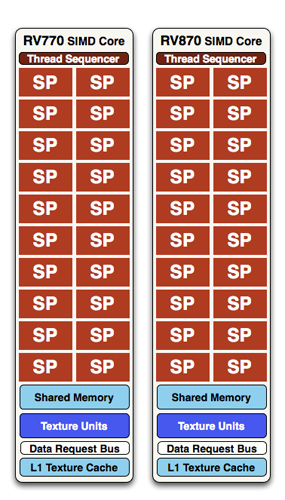
At a high level, the RV770 and Cypress SIMDs look very similar
The texture units located here have also been reworked. The first of these changes are that they can now read compressed AA color buffers, to better make use of the bandwidth they have. The second change to the texture units is to improve their interpolation speed by not doing interpolation. Interpolation has been moved to the SPs (this is part of DX11’s new Pull Model) which is much faster than having the texture unit do the job. The result is that a texture unit Cypress has a greater effective fillrate than one under RV770, and this will show up under synthetic tests in particular where the load-it and forget-it nature of the tests left RV770 interpolation bound. AMD’s specifications call for 68 billion bilinear filtered texels per second, a product of the improved texture units and the improved bandwidth to them.
Finally, if we move up another level, here is where we see the cause of the majority of Cypress’s performance advantage over RV770. AMD has doubled the number of SIMDs, moving from 10 to 20. This means twice the number of SPs and twice the number of texture units; in fact just about every statistic that has doubled between RV770 and Cypress is a result of doubling the SIMDs. It’s simple in concept, but as the SIMDs contain the most important units, it’s quite effective in boosting performance.
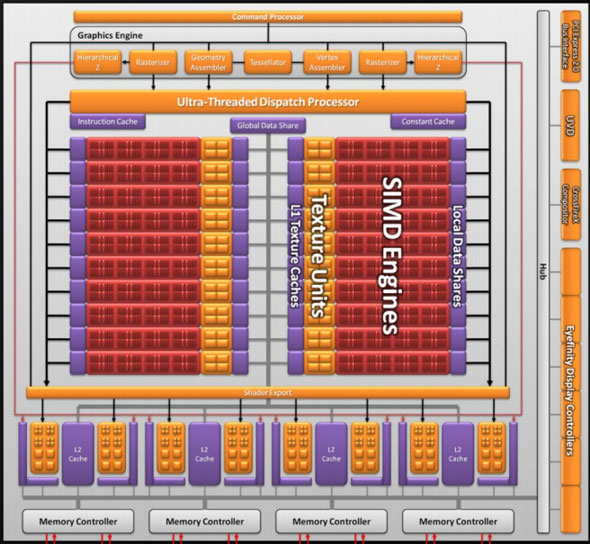
However with twice as many SIMDs, there comes a need to feed these additional SIMDs, and to do something with their products. To achieve this, the 4 L2 caches have been doubled from 64KB to 128KB. These large L2 caches can now feed data to L1 caches at 435GB/sec, up from 384GB/sec in RV770. Along with this the global data share has been quadrupled to 64KB.
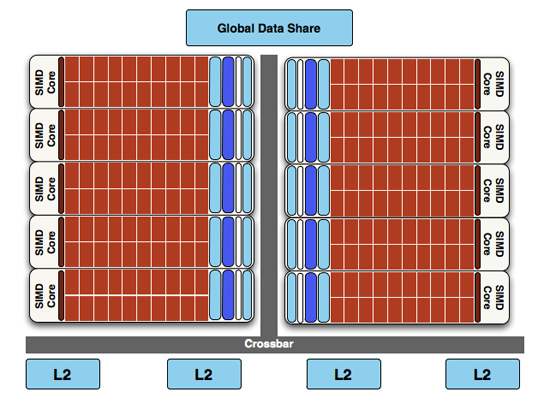
RV770 vs...
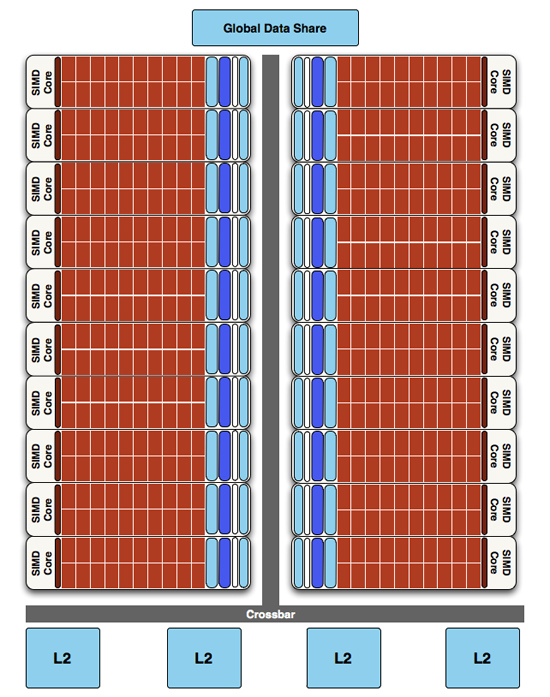
Cypress
Next up, the ROPs have been doubled in order to meet the needs of processing data from all of those SIMDs. This brings Cypress to 32 ROPs. The ROPs themselves have also been slightly enhanced to improve their performance; they can now perform fast color clears, as it turns out some games were doing this hundreds of times between frames. They are also responsible for handling some aspects of AMD’s re-introduced Supersampling Anti-Aliasing mode, which we will get to later.

Last, but certainly not least, we have the changes to what AMD calls the “graphics engine”, primarily to bring it into compliance with DX11. RV770’s greatly underutilized tessellator has been upgraded to full DX11 compliance, giving it Hull Shader and Domain Shader capabilities, along with using a newer algorithm to reduce tessellation artifacts. A second rasterizer has also been added, ostensibly to feed the beast that is the 20 SIMDs.










327 Comments
View All Comments
SiliconDoc - Friday, September 25, 2009 - link
LOL - you won't find me arguing, but that performance per dollar here is absolutely FAMOUS for guess whom, ati !Congratulations, for the first time someone other than myself conplained about it, of course, only when ATI has been implicated as a disaster in it.
--
PS - I think what the chart is saying is, use some common sense, not go for 9500, but in your range you hope to purchase, the chart can be handy for picking between several.
--
Also, the chart tells us, the 5870 is not bang for the buck.
-
So, so sorry, it upset you so badly, the tips above for proper useage should be fine.
KaarlisK - Wednesday, September 23, 2009 - link
Actually, far more developers care about the next version of DirectX (pc-industry-wide vendor-independent development platform) than about PhysX (single vendor, low uptake currently). Not that PhysX would be unimportant.SiliconDoc - Wednesday, September 23, 2009 - link
Not quite time yet, you can "pre-order" one of 3 versions at tiger..LOLThis is not a "hard launch", this is a red RUSE !
--
http://www.tigerdirect.com/applications/SearchTool...">http://www.tigerdirect.com/applications/SearchTool...
SiliconDoc - Wednesday, September 23, 2009 - link
Ok, hurry, the paper launch finally "cracked" a bit and there's one card of 4 5870's on newwegg that is suposedly "available for purchase".http://www.newegg.com/Product/ProductList.aspx?Sub...">http://www.newegg.com/Product/ProductLi...1&na...
It's 1:33pm on the 23rd, so no guarantees there's more than 0 for actual sale....
Good luck on getting something other than paper. :-)
jabroni619 - Wednesday, September 23, 2009 - link
I'd better not get paper... I was able to place an order at newegg at midnight when they were available and 18 hours later it's showing a status of shipped. ;)SiliconDoc - Wednesday, September 23, 2009 - link
7:08PM CST Wed. Sept 23rd, 2009 -Out of the 9 "reviews" by "customers" on newegg for the 5870 card, only ONE of them has the revealing:
" This user purchased this item from Newegg " in blue by their name on the customer reviews tab.
LOL
So it looks like 8 posers and you. Hope you enjoy the XFX 5870,
"WoostaR"
WoostaR - Friday, October 2, 2009 - link
Thanks man, I actually went with 2 5870's. I know it's bit of overkill, yet future proof is better =)anyways, I have gotten over 17000 of 3dMark06. That's with Cpu.
I am running Core i7 @ 4 ghz
6GB of Gskill ram
Dual 5870 @ CF
750W Corsair.
EVGA 3x SLI
jabroni619 - Thursday, September 24, 2009 - link
Oh, and I didn't get the XFX, I got HIS. XFX wasn't even showing up when I placed my order. Only Sapphire, ASUS and HIS were, both the Sapphire and ASUS were OOS.jabroni619 - Thursday, September 24, 2009 - link
I haven't written a review yet as I haven't gotten the card. (hate it when people do that) I was a little worried up until just a few minutes ago when my UPS tracking# actually had some data. Estimated Delivery of 9/24/09. Hopefully it's waiting at the front door when I get home from work. I just spend the last 2 hours moving all the guts of my PC into a larger case to accommodate the card.SiliconDoc - Friday, September 25, 2009 - link
Apparently your luck is immaculate.http://www.fudzilla.com/content/view/15673/1/">http://www.fudzilla.com/content/view/15673/1/
" We talked to partners and some of them might have a few cards next week and October is the month when things should get better.
The big guys such as Newegg and Tigerdirect don’t have them, and in EU, a hundred plus cards are listed here, but none of them are available.
A launch partner in the UK got 20 cards ...
We hope that Radeon 5870 is not what AMD management calls a hard launch "
ROFL - At least one place doesn't have to censor itself